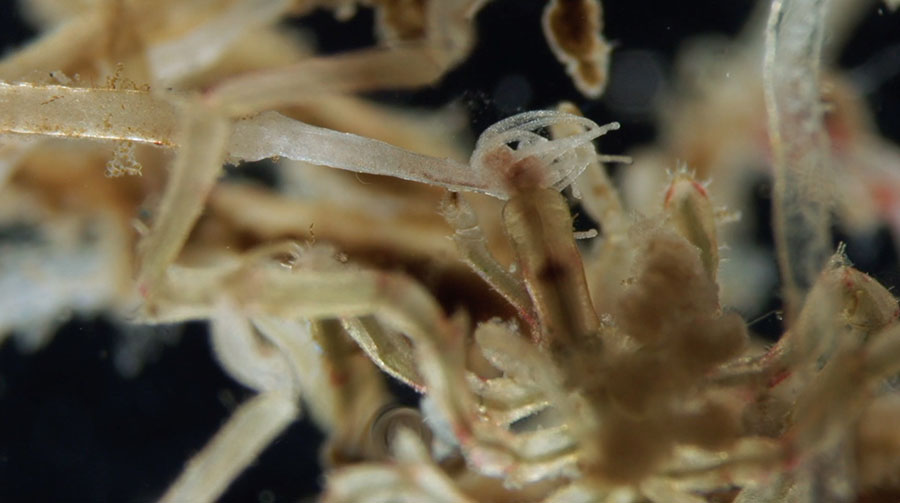 Oct. 19, 2020 — Dinosaurs were not yet roaming the earth when an invertebrate known as the sea spider was beginning to evolve in the oceans 500 million years ago.
Oct. 19, 2020 — Dinosaurs were not yet roaming the earth when an invertebrate known as the sea spider was beginning to evolve in the oceans 500 million years ago.
“They’re still evolving today and they’ve diversified in amazing ways,” said CSU Channel Islands (CSUCI) Associate Professor of Biology Geoff Dilly, Ph.D. “You can find them in tropic coral reefs or polar waters in the North or South Pole. They are found in every ocean in the deep sea. Some are three feet across and some are fingernail-sized off the Channel Islands.”
By collecting and meticulously sequencing their DNA, Dilly and researchers from 12 other universities and research institutes in five countries became the first to determine that the sea spider’s evolution can be traced in an unbroken line for 500 million years. The findings were the culmination of five years of work.
“They have survived everything,” Dilly said. “They have experienced four mass extinction events, they survived volcanic explosions, ice ages and meteors. Before this research was conducted, we didn’t realize these sea spiders (pycnogonids) were as old as 500 million years. Our paper was the first one to resolve that question.”
This work was recently published in Molecular Biology and Evolution a prestigious top journal in the field of evolutionary biology. It was additionally reported on by Science Magazine, by the American Academy for the Advancement of Science.
Virtually every other modern arthropod on earth—from spiders to lobsters to mites, insects and millipedes—have evolved after the sea spider, Dilly said.
The research was spearheaded by a friend and scientific colleague of Dilly’s—University of Wisconsin Assistant Professor of Biology Prashant Sharma, Ph.D., whose specialty is evolutionary biology. Sharma had a grant to trace and refine the genetic coding of the sea spider to find out 1) how long ago they began to evolve; and 2) what sort of diversity exists on the planet.
“These kinds of projects really do require diverse teams and a multitude of talents to understand the history of these mysterious animals,” Sharma said. “It’s been fantastic to watch undergraduates from CSUCI bring their energy and enthusiasm to our international team.”
 With the help of professional divers, scientists collected and genetically coded nearly 90 of the 1300 species of sea spiders that exist in all of the world’s oceans in the most comprehensive phylogenetic study to date. Sea spiders were collected from the tropics to the frozen polar seas, including sea spiders off the coast of the Channel Islands.
With the help of professional divers, scientists collected and genetically coded nearly 90 of the 1300 species of sea spiders that exist in all of the world’s oceans in the most comprehensive phylogenetic study to date. Sea spiders were collected from the tropics to the frozen polar seas, including sea spiders off the coast of the Channel Islands.
Diving under the ice of Antarctica for large sea spiders was Rob Robbins, the head of the U.S. Antarctic Program’s dive group. Combing the tropical reefs for sea spiders was a team from the University of Hawaii under the direction of Associate Professor of Marine Ecology & Evolution, Amy Moran, Ph.D.
Dilly, with the help of five current and former CSUCI biology students retrieved genetic sequences of 60 different genes found in sea spiders, bringing the genetic sequences into a sharper focus so scientists can build evolutionary trees.
“It was exciting to dig into a new niche of biology with a goal in mind,” said Biology major Sean McAtee. “I read so many academic papers on genetics and computer science for the project, it felt like I was taking an extra class! But the chance to help the team was incredibly motivating.”
Although they have survived for 500 million years, Dilly said the vast diversity of the sea spiders may be vulnerable to climate change—especially in the waters around the North and South poles. This group of sea spiders includes rare species of giant sea spider the size of dinner plates, which may be susceptible to extinction in the next 100 years.
Dilly hopes that with research creatures whose genes have logged millions of years of existence might lead us to answers about the origins of our earth.
“The value to us as humans may not be medical and it won’t help climate change, but better understanding our planet will help us better understand where we came from,” Dilly said. “It’s one of the most driving human questions.”
To view the research in Molecular Biology & Evolution: doi.org/10.1093/molbev/msaa228.
